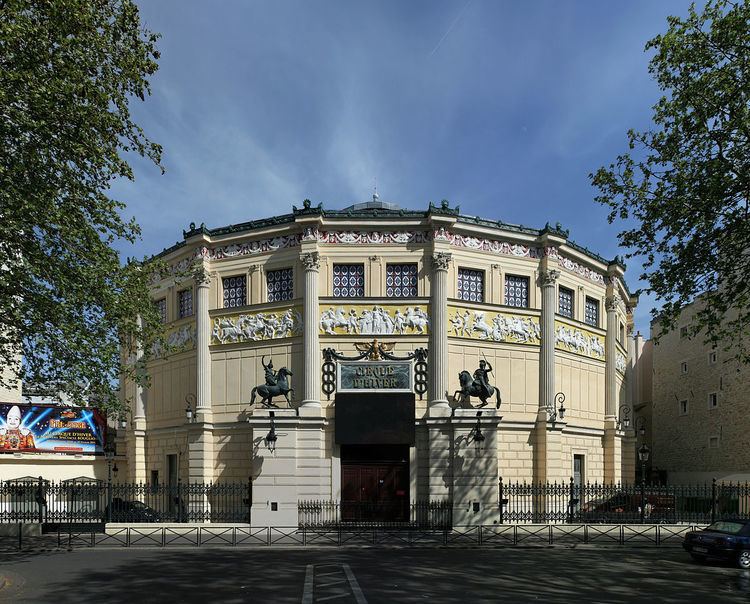Opened 1852 | Phone +33 1 47 00 28 81 | |
 | ||
Hours Closed now Sunday11AM–7PMMonday11AM–7PMTuesday11AM–7PMWednesday11AM–7PMThursday11AM–7PMFriday11AM–7PMSaturday11AM–7PM Similar Place de la Bastille, Filles du Calvaire, Musée Édith Piaf, Saint‑Ambroise - Paris, Place de la République Profiles | ||
Cirque d hiver paris 2015 highlights
The Cirque d'Hiver ("Winter Circus"), located at 110 rue Amelot (at the juncture of the rue des Filles Calvaires and rue Amelot, Paris 11ème), has been a prominent venue for circuses, exhibitions of dressage, musical concerts, and other events, including exhibitions of Turkish wrestling and even fashion shows. The theatre was designed by the architect Jacques Ignace Hittorff and was opened by Emperor Napoleon III on 11 December 1852 as the Cirque Napoléon. The orchestral concerts of Jules Etienne Pasdeloup were inaugurated at the Cirque Napoléon on 27 October 1861 and continued for more than twenty years. The theatre was renamed Cirque d'Hiver in 1870.
Contents
- Cirque d hiver paris 2015 highlights
- Vlog nouveau spectacle du cirque d hiver bouglione en famille
- HistoryEdit
- The circus in fictionEdit
- References
The nearest métro station is Filles du Calvaire.
Vlog nouveau spectacle du cirque d hiver bouglione en famille
HistoryEdit
The circus is an oval polygon of 20 sides, with Corinthian columns at the angles, giving the impression of an oval building enclosing the oval ring, surrounded by steeply banked seating for spectators, very much like a miniature indoor Colosseum. A low angled roof is self-supporting like a low dome, so that there is no central pole, as under a tent, to obstruct views or interfere with the action. The building was designed by the architect Jacques Ignace Hittorff and opened as the Cirque Napoléon, a compliment to the new Emperor of the French Napoleon III. The sculptor James Pradier was called upon to provide exterior bas-reliefs of Amazons, and Francisque Duret and Astyanax-Scévola Bosio sculpted the panels of mounted warriors. The guiding entrepreneur was Louis Dejean, the proprietor of the Cirque d'Été ("Summer Circus") erected annually in the bosquets that flanked the Champs-Élysées. Dejean wagered that evening circus performances under the limelight, with the spectators well removed from the dust and smells of the tanbark floor, would provide a dress occasion for le tout-Paris and he was well rewarded for his acumen.
After the Second Empire, the Cirque d'Hiver was administered by Victor Franconi. Henri de Toulouse-Lautrec repeatedly found inspiration in rehearsals and performances at the Cirque d'hiver; Georges Seurat painted an afternoon performance, with a distinctly middle-class audience, in The Circus, one of the greatest unfinished canvasses in the history of Western painting (1890–91, Musée d'Orsay). Franconi's son Charles assumed direction, 1897 – 1907. Since 1934 it has been the Cirque d'Hiver-Bouglione, operated by the Bouglione brothers and their heirs. The original configuration accommodated 4,000, which has now been reduced to 2,090 due to fire codes. At the Cirque d'Hiver in August 1955, Richard Avedon took his famous photograph of the fashion model "Dovima with the Elephants" to show a floor-length evening dress by Dior, one of the most iconic fashion photographs of the century. In 1995, Parisian designer Thierry Mugler held a special fashion show at the circus, to celebrate his firm's 20th anniversary. Performers and special guests included James Brown, Tippi Hedren and many of the decade's top supermodels, including Naomi Campbell.
